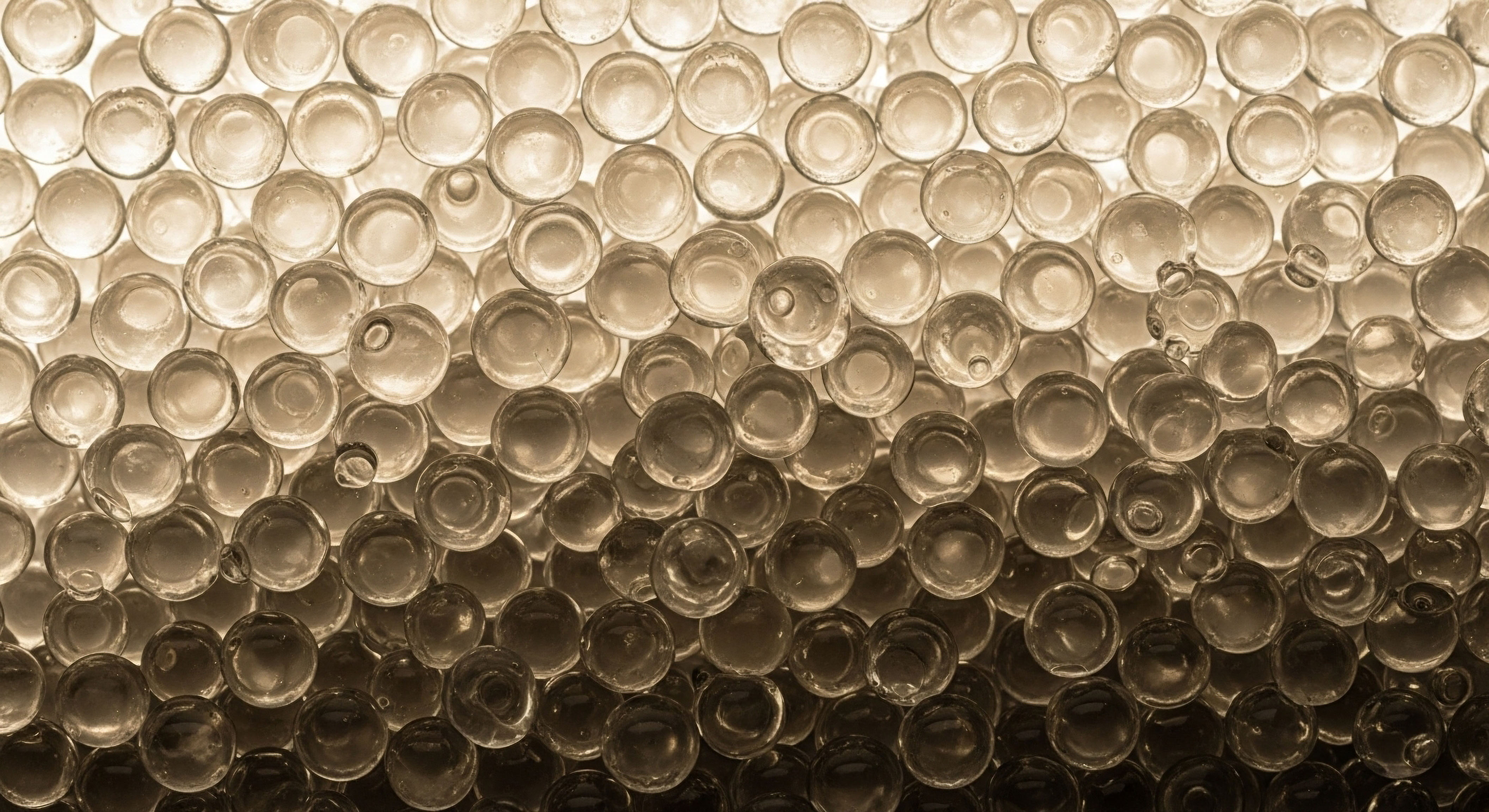

Fundamentals
That feeling of puffiness, the unanticipated swelling in your hands and feet, or the bloating that seems to appear without a clear dietary cause, is a deeply personal and often frustrating experience. It is a physical sensation that can affect your comfort, your confidence, and your overall sense of well-being.
The question of whether lifestyle adjustments alone can resolve this hormonally driven fluid retention is a valid and pressing one. The answer lies in understanding the intricate communication network within your body, a system where hormones act as powerful messengers, dictating how your cells and organs manage fluid balance.
These signals are fundamental to your body’s operating system, and when they fluctuate, the physical manifestations can be unsettling. Acknowledging this connection is the first step in decoding your own biology and moving toward a solution that feels both empowering and effective.
Your body’s management of water is a dynamic process, governed by a sophisticated interplay of hormones and electrolytes. At the center of this regulation is a delicate balance between sodium and water, orchestrated primarily by the kidneys. Hormones are the conductors of this orchestra, ensuring that every system has the precise amount of fluid it needs to function.
When hormonal levels shift, as they naturally do throughout different life stages or due to external factors, the instructions sent to your kidneys can change. This can lead to the retention of sodium, and because water follows sodium, fluid begins to accumulate in your tissues, leading to the sensation of bloating or swelling. This is a direct, physiological response to a change in your internal chemical environment. It is your body adapting to a new set of instructions.
Hormonal fluctuations directly influence the kidneys’ ability to manage sodium and water, which is the primary driver of fluid retention.

The Key Hormonal Players in Fluid Balance
Several key hormones are central to the story of fluid retention. Understanding their roles provides a clear map of the biological processes at play. These are not isolated actors; they work in concert, influencing one another in a complex feedback system that maintains your body’s internal equilibrium.

Estrogen and Progesterone the Female Cycle
For many women, the experience of fluid retention is closely tied to the menstrual cycle. This is due to the cyclical rise and fall of estrogen and progesterone. Estrogen, particularly in high amounts, can signal the body to retain sodium and water.
This is why many women experience bloating in the days leading up to their period, when estrogen levels can be elevated relative to progesterone. Progesterone, on the other hand, can have a mild diuretic effect, helping to offset the fluid-retaining properties of estrogen by competing with another hormone, aldosterone, at its receptor sites in the kidneys.
When the ratio of these two hormones is altered, particularly during perimenopause and menopause, the signals for fluid retention can become more pronounced and less predictable.

Cortisol the Stress Hormone
Cortisol, your body’s primary stress hormone, also plays a significant role in fluid balance. While its main job is to manage your response to stress and regulate metabolism, it has a structural similarity to aldosterone, the body’s main salt-retaining hormone.
When cortisol levels are chronically elevated due to prolonged stress, it can begin to bind to and activate the mineralocorticoid receptors that are typically reserved for aldosterone. This “cross-reactivity” essentially tricks your kidneys into holding onto more sodium and water than they should, leading to fluid retention. This is a prime example of how your emotional state and your physiological state are inextricably linked.

Testosterone and Fluid Shifts
In men, and to a lesser extent in women, testosterone levels can also influence fluid balance. Testosterone Replacement Therapy (TRT) is sometimes associated with water retention, particularly when treatment is initiated. This can occur for a couple of reasons. Higher levels of testosterone can be converted into a form of estrogen through a process called aromatization.
This increase in estrogen can then lead to sodium and water retention. Additionally, testosterone itself can have a direct effect on the kidneys’ handling of sodium. Managing fluid retention in this context often involves careful calibration of testosterone dosage and sometimes includes medications to block the conversion to estrogen, ensuring that hormonal optimization does not come at the cost of fluid imbalance.


Intermediate
While lifestyle modifications form the essential foundation for managing hormonally driven fluid retention, there are instances where they may not be sufficient to fully correct the underlying imbalance. When the hormonal signals themselves are significantly dysregulated, a more direct intervention may be required to recalibrate the system.
This is where targeted clinical protocols, designed to restore hormonal equilibrium, become a powerful tool. These protocols are built on a deep understanding of the endocrine system’s feedback loops and are designed to work with your body’s natural physiology, not against it. The goal is to move beyond simply managing symptoms and instead address the root cause of the fluid imbalance, which is the hormonal miscommunication itself.
The decision to implement a clinical protocol is always preceded by a thorough diagnostic process, including comprehensive lab work. This allows for a precise identification of which hormones are out of balance and to what degree. This data-driven approach ensures that any intervention is tailored to your specific biochemical needs.
The protocols themselves are multifaceted, often involving the use of bioidentical hormones, specific peptides, or medications designed to modulate hormonal activity. These are not one-size-fits-all solutions; they are personalized therapeutic strategies designed to restore optimal function.

Hormone Optimization Protocols for Fluid Management
When fluid retention is a persistent issue, particularly for women in perimenopause or menopause, or for men on TRT, hormone optimization protocols can be highly effective. These protocols are designed to restore the delicate balance between key hormones, thereby correcting the signals that lead to fluid retention.

Female Hormone Balancing
For women experiencing fluid retention due to fluctuating estrogen and progesterone levels, a carefully balanced hormone replacement therapy (HRT) protocol can provide significant relief. The approach is nuanced, aiming to restore a more youthful and stable hormonal environment.
- Progesterone Use ∞ Natural, bioidentical progesterone is often a cornerstone of these protocols. Because of its ability to compete with aldosterone at the mineralocorticoid receptor, progesterone can have a natural diuretic effect, helping to counteract the fluid-retaining effects of estrogen. Its use is carefully timed to mimic the natural menstrual cycle in pre-menopausal women or administered continuously in post-menopausal women.
- Testosterone for Women ∞ Low-dose testosterone therapy is also increasingly recognized for its benefits in women, including improved energy, mood, and libido. When it comes to fluid balance, the key is precise dosing. A small amount of testosterone can support overall well-being without significantly impacting fluid dynamics. However, monitoring for any potential conversion to estrogen is important, and dosages are adjusted accordingly.

Testosterone Replacement Therapy in Men
For men undergoing TRT, managing fluid retention is a matter of optimizing the protocol to minimize side effects. This involves a multi-pronged approach that addresses both testosterone levels and their downstream metabolites.
The following table outlines the standard components of a TRT protocol designed to mitigate fluid retention:
| Component | Purpose | Mechanism of Action |
|---|---|---|
| Testosterone Cypionate | Hormone Replacement | Restores testosterone to optimal physiological levels. |
| Anastrozole | Estrogen Blocker | An aromatase inhibitor that prevents the conversion of testosterone to estrogen, thereby reducing estrogen-related water retention. |
| Gonadorelin | Maintain Natural Production | Stimulates the pituitary gland to maintain some natural testosterone production, which can help in maintaining a more balanced hormonal milieu. |

What Are the Limits of Lifestyle Changes?
Lifestyle changes, including dietary modifications, exercise, and stress management, are profoundly impactful. They can improve insulin sensitivity, reduce cortisol, and support overall metabolic health. However, when there is a significant, clinically-diagnosed hormonal deficiency or imbalance, lifestyle changes alone may not be able to fully bridge the gap.
For instance, no amount of dietary change can restore testosterone production in a man with primary hypogonadism, nor can it fully compensate for the loss of estrogen and progesterone in a post-menopausal woman. In these cases, lifestyle changes become a critical adjunct to clinical protocols, creating an internal environment where hormone therapy can be most effective and well-tolerated. They work synergistically, with lifestyle improvements enhancing the body’s response to targeted hormonal interventions.
Clinical protocols aim to correct the root hormonal imbalances that lifestyle changes alone may not be able to resolve.
Peptide therapies represent another advanced clinical strategy that can indirectly influence fluid balance by optimizing growth hormone levels. Peptides like Sermorelin and Ipamorelin stimulate the body’s own production of growth hormone, which can improve body composition and metabolic function. While generally well-tolerated, a potential side effect, particularly at the beginning of therapy, can be mild fluid retention.
This is typically transient and resolves as the body adapts to the new hormonal signals. Careful dosing and monitoring are key to minimizing this effect and ensuring that the benefits of the therapy are realized without unwanted side effects.


Academic
A sophisticated understanding of hormonally mediated fluid retention requires a deep exploration of the renin-angiotensin-aldosterone system (RAAS). This complex, multi-organ endocrine cascade is the master regulator of blood pressure, electrolyte balance, and extracellular fluid volume.
While lifestyle factors can modulate its activity, the system’s function is profoundly influenced by the direct and indirect actions of sex hormones and glucocorticoids. The question of whether lifestyle changes alone can correct hormonally driven fluid retention is, from a mechanistic standpoint, a question of whether those changes can override the powerful, genetically programmed signals that hormones exert upon the RAAS.
The RAAS is a tightly regulated feedback loop. When the kidneys sense a drop in blood pressure or fluid volume, they release an enzyme called renin. Renin initiates a cascade that results in the production of angiotensin II, a potent vasoconstrictor that also stimulates the adrenal glands to release aldosterone.
Aldosterone then acts on the distal tubules of the kidneys, promoting the reabsorption of sodium and, consequently, water. This elegant system is designed to maintain homeostasis, but it is also highly susceptible to hormonal influence, which can shift its set points and lead to a state of chronic fluid retention.

Hormonal Interplay with the Renin Angiotensin Aldosterone System
The interaction between sex hormones and the RAAS is a critical area of study for understanding fluid dynamics, particularly in women. Estrogen and progesterone exert distinct and sometimes opposing effects on this system, and their balance is a key determinant of fluid homeostasis.

Estrogen’s Influence on RAAS Components
Estrogen has a complex relationship with the RAAS. Oral estrogens, in particular, have been shown to increase the hepatic synthesis of angiotensinogen, the precursor to angiotensin II. This increase in substrate can lead to a compensatory decrease in renin secretion, but the net effect can still be an increase in angiotensin II levels, which promotes vasoconstriction and aldosterone release.
This mechanism helps to explain the fluid retention and potential for increased blood pressure that can be associated with some forms of oral hormone therapy. The route of administration matters; transdermal estrogen appears to have a less pronounced effect on angiotensinogen production, highlighting the nuances of clinical protocols.

Progesterone’s Counterbalancing Role
Progesterone acts as a natural antagonist to aldosterone at the mineralocorticoid receptor (MR). By binding to the MR without activating it as strongly as aldosterone, progesterone competitively inhibits aldosterone’s action, leading to a mild natriuresis, or excretion of sodium.
This action is a key reason why the luteal phase of the menstrual cycle, when progesterone is high, does not always result in significant fluid retention, despite elevated estrogen levels. The balance between estrogen’s tendency to upregulate the RAAS and progesterone’s ability to block its final effector, aldosterone, is crucial. Synthetic progestins used in some contraceptive formulations may lack this beneficial antimineralocorticoid effect, which can unmask the fluid-retaining properties of the estrogen component.

Could Cortisol Overload the System?
The role of cortisol in fluid retention extends beyond simple stress responses; it involves a phenomenon of receptor saturation and cross-reactivity that can have significant clinical implications. Under normal physiological conditions, the enzyme 11-beta-hydroxysteroid dehydrogenase type 2 (11β-HSD2) is present in aldosterone-sensitive tissues, such as the kidneys. This enzyme rapidly converts active cortisol into inactive cortisone, thereby protecting the mineralocorticoid receptor from being overwhelmed by the much higher circulating concentrations of cortisol compared to aldosterone.
However, in states of chronic stress or in conditions like Cushing’s syndrome where cortisol levels are pathologically high, the capacity of 11β-HSD2 can be saturated. When this happens, the excess cortisol is free to bind to and activate the MR, mimicking the effects of aldosterone and leading to significant sodium and water retention, hypertension, and hypokalemia.
This demonstrates a critical vulnerability in the system, where a hormone primarily involved in metabolism and stress can hijack the machinery of fluid and electrolyte balance. Lifestyle interventions aimed at reducing chronic stress and lowering cortisol levels can help to restore the efficacy of the 11β-HSD2 protective barrier, but in cases of severe cortisol excess, they may be insufficient without medical intervention to address the underlying cause.
The intricate dance between sex hormones and the renin-angiotensin-aldosterone system is central to understanding and managing fluid retention.
The following table details the interactions of key hormones with the RAAS, providing a clear overview of their mechanisms of action:
| Hormone | Primary Effect on RAAS | Mechanism |
|---|---|---|
| Estrogen | Upregulation | Increases hepatic synthesis of angiotensinogen, the precursor to angiotensin II. |
| Progesterone | Antagonism | Competitively binds to the mineralocorticoid receptor, blocking the action of aldosterone. |
| Cortisol (in excess) | Activation | Saturates the 11β-HSD2 enzyme, allowing it to bind to and activate the mineralocorticoid receptor. |
| Testosterone | Variable | Can be aromatized to estrogen, which upregulates the RAAS. May also have direct renal effects. |
Ultimately, while lifestyle modifications are foundational and can significantly improve the body’s ability to manage fluid, they operate within the constraints of the existing hormonal environment. When that environment is fundamentally altered by menopause, andropause, or a clinical endocrine disorder, the signaling to the RAAS may be too powerful to be overcome by diet and exercise alone.
In these scenarios, personalized hormone optimization protocols are not merely treating a symptom; they are correcting a fundamental dysregulation in a core homeostatic system, allowing lifestyle strategies to become fully effective.

References
- Stachenfeld, N. S. “Hormonal changes during menopause and the impact on fluid regulation.” Journal of the American Heart Association, vol. 3, no. 4, 2014, e000922.
- O’Donnell, E. et al. “Estrogen status and the renin angiotensin aldosterone system.” American Journal of Physiology-Regulatory, Integrative and Comparative Physiology, vol. 307, no. 5, 2014, pp. R498-R500.
- Fuller, P. J. and Young, M. J. “The multifaceted mineralocorticoid receptor.” Endocrine Reviews, vol. 26, no. 1, 2005, pp. 89-110.
- White, W. B. et al. “Effects of oral and transdermal estrogen replacement therapy on the renin-angiotensin system and blood pressure in postmenopausal women.” Journal of Clinical Endocrinology & Metabolism, vol. 86, no. 10, 2001, pp. 4997-5003.
- Gomez-Sanchez, E. P. et al. “Relationship between aldosterone and progesterone in the human menstrual cycle.” Journal of Clinical Endocrinology & Metabolism, vol. 93, no. 11, 2008, pp. 4453-4459.
- Southwest Integrative Medicine. “Does TRT Make You Retain Water?”. Southwest Integrative Medicine, 2023.
- Evolve Medical Group. “Ipamorelin Side Effects ∞ What You Should Know”. Evolve Medical Group, 2023.
- Young, M. J. et al. “Aldosterone and mineralocorticoid receptors ∞ physiology and pathophysiology.” Journal of Inherited Metabolic Disease, vol. 42, no. 5, 2019, pp. 784-790.
- Pizzorno, L. “Synergistic interplay between cortisol and aldosterone ∞ unveiling mechanisms of vascular calcification in hyperaldosteronism.” Hypertension Research, vol. 48, no. 3, 2025, pp. 1231-1233.
- Yunique Medical. “Ipamorelin Side Effects ∞ Unlocking Potential, Balancing Risks”. Yunique Medical, 2024.

Reflection

Charting Your Own Biological Course
You have now journeyed through the complex, interconnected world of your endocrine system, seeing how the subtle shifts in hormonal messengers can manifest as tangible physical symptoms like fluid retention. This knowledge is more than just information; it is the toolkit for self-awareness.
The sensations you feel in your body are not random; they are part of a coherent, biological narrative. As you move forward, consider this understanding as a new lens through which to view your own health. The path to reclaiming vitality is a personal one, built on a foundation of deep, individualized knowledge.
What are the unique patterns your body is communicating to you? How can you use this insight to ask more precise questions and seek solutions that are truly tailored to your unique physiology? The journey begins with this new level of awareness, empowering you to become an active participant in your own wellness story.



